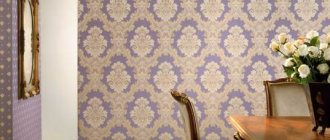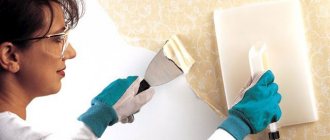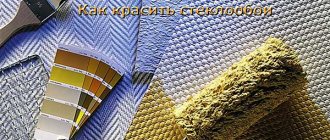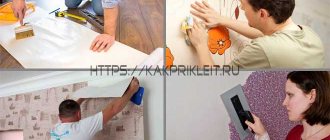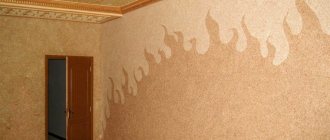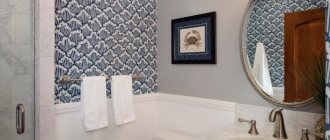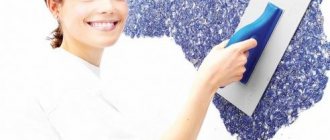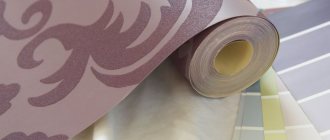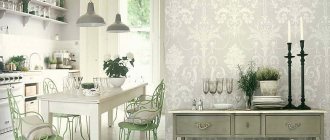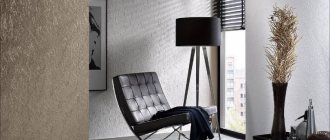Nowadays, almost every housewife thinks about the important, sometimes even painful issue of finding the optimally convenient and high-quality material for decorating bathrooms, kitchens, and hallways. After all, it is in these rooms that the humidity is high and fungus and mold often appear. New technologies for creating special materials that are resistant to moisture have prompted the fact that multifunctional washable wallpaper, which is durable and resistant to water, fungal mold, dust and dirt, has begun to actively gain popularity.
Types and features of washable wallpaper
Advantages that distinguish moisture-resistant wallpaper from other types of finishes:
- quickly and efficiently applied to any type of surface: plaster, drywall, concrete, panels;
- washable wallpaper will last a long time and of high quality if used correctly and will retain its individual properties;
- this type of coating is easily and quickly removed.
Washable wallpaper is not afraid of moisture, so it can be used in bathrooms.
There are several types of washable wallpaper that have individual characteristics and functional purposes.
- Thick vinyl sheets, or kitchen washable wallpaper, are based on paper coated with vinyl. These coatings entered the market quite recently and, nevertheless, managed to receive good reviews due to their durability. Thanks to the vinyl coating, these canvases are moisture resistant and durable. The approximate lifespan of such wallpaper is about fourteen years. They do not fade in the sun, maintaining their original appearance for a long time. To prevent harmful mold from appearing, the canvases are impregnated with special preparations that easily deal with fungus, but are completely harmless to human health.
- Washable non-woven wallpaper with a moisture-resistant coating is distinguished by its wear resistance. With their help it is very convenient to hide errors on the walls. Providing a tight fit, non-woven fabrics do not react to shrinkage of the house, which makes them an ideal option for use in new buildings. In modern wallpaper collections you can choose a pattern, color and texture to suit every taste.
- Foamed vinyl wallpaper is thick and voluminous in texture. However, they are very convenient in their functional use, which does not cause any particular difficulties in working with them. They perfectly hide minor signs of poor-quality repairs, thanks to the rough surface structure. Such canvases can be washed without worrying about the safety of the design and without fear of ruining the protective coating. You can do this as often as necessary.
- Liquid wallpaper is a special water-based plaster. Working with them has some peculiarities. They are applied with a spatula to prepared, primed walls. Washing liquid wallpaper coated with waterproof acrylic varnish is also not difficult.
Color selection
The color of wallpaper for the kitchen is chosen based on the style and dimensions of the room. Dark colors are not suitable for small kitchens, as they visually narrow the space, so it is better to choose light colors with a small pattern. In spacious kitchens, the choice of shade is unlimited. Ideal kitchen shades are:
- White. This color has many advantages. It can be combined with different shades, it is appropriate in any style and visually enlarges the kitchen. White can be a basic color or combined with bright contrasts.
- Green. The choice of shades is large - from fresh greenery to dark olive. Saturated colors are best used in a large kitchen with good lighting. Also, the color should be in harmony with the kitchen style, for example, bright colors are appropriate in modern styles, and muted colors for classic ones.
- Beige. This is a universal color suitable for any style and size of kitchen. It appears in one finishing color or harmonizes with a bright palette.
- Black. This color is chosen only for large, open kitchens. More often it is found in ornaments on washable canvases.
Gluing technology
We will try to briefly describe how to glue washable wallpaper in order to achieve the final desired result without much effort. The entire strip is coated well, including the joints. It is imperative to press the canvas tightly against the wall and expel the air with a roller to prevent bubbles from forming. The movement of the roller should be directed from the center of the canvas to its edges.
Thanks to the thick base of this wallpaper, it is possible to peel and stick it several times until you achieve the desired result. For an ideal appearance, you need to match the edges of the canvases end-to-end, then the seams will not be noticeable. But this same dense structure forces you to carefully consider the choice of suitable glue. For such materials, a special adhesive with a reinforced formula is intended. It is desirable that it has an antiseptic effect, with the addition of fungicidal substances.
Moisture-resistant canvases are usually heavier than regular ones, so when choosing glue for them, you need to take this feature into account
It is necessary to attach the strip to a surface previously treated with a primer, which will significantly save the consumption of adhesive liquid. Despite the fact that vinyl wallpaper most often has a non-woven base, both the wall and the canvas itself should be coated with glue.
Step-by-step instructions on how to glue
Most washable wallpaper for the kitchen is heavy, so the adhesive is selected accordingly. Before starting work, the surface of the walls is prepared, and the work is performed in accordance with the rules:
- Prepare the walls - remove the old covering, clean it of dust, dirt and dry it. Some types of wallpaper, for example, paper, photo wallpaper, require preliminary leveling of the walls. Then the surface needs to be primed and large flaws and cracks filled with putty.
- Then you need to apply markings - draw a straight line from the ceiling to the floor using a building level, which will become a guide when gluing the wallpaper.
- Prepare the material by cutting the wallpaper into strips of the desired size. Be sure to allow an allowance of 10 cm.
- Depending on the type of wallpaper, apply glue to the walls or strips and apply to the wall. Carefully process the joints - they should be well coated.
- Straighten the wallpaper with a rubber roller, rolling it from the middle to the edges.
Excess glue on the wallpaper is removed immediately. At the end of the work, excess wallpaper is trimmed with a sharp knife.
How to wash washable wallpaper
With every spring cleaning, the question arises: how to wash wallpaper? It can be solved very easily. Dirt from the surface can be removed with a damp cloth or soft brush, with the addition of various household chemicals. Alternatively, use regular laundry soap. You can also use liquid laundry detergent.
In any case, before cleaning the entire surface, be sure to select a piece that is not particularly visible and test the cleaning agent on it so as not to ruin the entire canvas. If everything is fine, you need to apply a soap solution to the wall and wash the dirt with smooth movements.
When using detergent to clean wallpaper for the first time, test it on an invisible area.
Let the canvas dry on its own, without ventilation or draft. If the stain is not washed off, wait a few days for both layers of wallpaper to dry. You can repeat the process of removing dirt, but do not overdo it so as not to spoil the coating, because frequent washing leads to rapid wear.
Calculation of the quantity of materials
First of all, you need to calculate the required number of rolls of wallpaper. The final figure depends on the size of your kitchen (perimeter and wall height) and the width of the roll. Its standard width is 0.53 or 1.06 m, length is 10 m (plus or minus a few cm).
When choosing wallpaper you should keep in mind:
- the larger the pattern of canvases you choose, the more rolls you will need;
- Narrow wallpaper (0.53 m) can be glued by one person, while wide wallpaper (1.06 m) requires more skill, so without relevant experience it is better to glue it together.
Wall perimeter
The perimeter of the room is measured in linear meters and is equal to the total length of the walls in the room. No matter how complex the configuration of your kitchen, you need to carefully measure the length of each wall with a tape measure (including protruding columns and boxes) and add up the resulting numbers. Example: P = 20.5 linear m.
Important! You should measure the length of the walls not along the floor, but slightly above the baseboard. It is also recommended to do this at two different levels (bottom and top) to avoid errors due to crooked corners. If the values differ, take the larger of them.
Number of sheets and rolls
To determine the number of canvases (KP), you need to divide the perimeter (P) by the width of the roll of wallpaper you have chosen (for example, 0.53 m). We get: 20.5 linear. m / 0.53 m = 38.7 pcs. We round this figure up and get CP = 39 pcs.
To calculate the number of rolls (KR), you need to measure the height of the walls of your kitchen (BC). Do this plumb, taking as a basis the larger of the obtained values, adding 2 cm to it. An allowance of 2 cm is needed to ensure safety in case of uneven cutting of the canvases. For example: BC = 2.48 m + 0.02 m = 2.5 m.
The number of rolls is calculated by the formula: KR = KP x (BC + 15 cm) / DR (pcs.), where:
- DR – roll length (almost always 10 m);
- 15 cm – margin for adjusting the wallpaper pattern.
Total: KR = 39 x (2.5 + 0.15) / 10 = 10.3 pcs. We round up and get the number of rolls - 11 pcs.
The margin for adjusting the pattern (15 cm) is the average value. It is not taken into account if the canvas has a small pattern or without it. If the pattern offset value exceeds 15 cm, substitute your value taken from the label on the roll (pattern adjustment icon) into the formula.
It looks like a vertical line, on both sides of which there are arrows located at different levels. Next to it should be a figure for the offset of the pattern in centimeters.
To be on the safe side, you can check yourself by comparing the area of all the kitchen walls with the area of the wallpaper you are purchasing. In our case: the area of the kitchen walls is 20.5 linear meters. m x 2.48 m = 50.84 sq. m, the area of 11 rolls of wallpaper is equal to 11 pcs. x 0.53 m x 10 m = 58.3 sq. m. As you can see, you have a reserve of about 8 sq. m. m (for adjusting the pattern and allowances).
You may notice that the area of door and window openings (which will not be covered) is not subtracted from the total area of the kitchen walls (50.84 sq. m). In most cases, kitchens have one door and one window, on average from 4 to 6 square meters. m.
This is done in the following cases:
- if you decide to entrust the wallpaper work to professionals, then it is pointless to take into account the scraps of wallpaper cut from the openings in the calculation (they do not use them in practice);
- in the case of a large drawing, it is problematic to use these trimmings;
- It is always better to have a supply of wallpaper in case of defects in one of the rolls or accidental damage; it is very difficult to find the same wallpaper from the same batch later.
If you decide to hang wallpaper yourself and the canvases you have chosen have a small pattern or do not have it at all, you can safely subtract the area of door and window openings, as well as the kitchen apron, from the total area of the walls by purchasing 1-2 less rolls.
The only condition is that the total area of the walls minus the openings and apron should not be greater than the total area of the purchased wallpaper rolls.
Glue calculation
The amount of glue is determined strictly according to the instructions on its packaging, where the consumption per 1 square meter should be indicated. m of treated surface. Particular attention should be paid to the purpose of the glue. For heavy wallpapers such as vinyl or fiberglass, special adhesives are used.
Tired of it! It's time to change the wallpaper
Let's look at several options for removing washable wallpaper without much effort.
It will not be possible to quickly remove this type of coating from the walls by wetting it as usual. In order for moisture to penetrate under the top layer, you will have to make many punctures or cuts, and only then try to saturate them with water. A regular steam iron or steam generator can facilitate this process. You just need to direct a stream of steam at the wall.
In addition, you can remove washable wallpaper from the wall layer by layer - first remove the waterproof surface layer, and then use water to remove the backing.
If you want the process of removing old wallpaper to happen as quickly as possible, you can use a special liquid, which is sold in many hardware stores and is designed specifically to facilitate this kind of task. But before you buy, you need to consult with the seller, he will help you choose a special product for removing exactly your type of wallpaper.
Flat vinyl
This is wallpaper with a smooth and dense, sometimes glossy surface. The coating does not absorb odors, is durable and easy to care for. In addition, flat vinyl is not exposed to sunlight and is resistant to mechanical damage. Initially, this type of wallpaper was intended specifically for bathrooms and kitchens, but today the scope of its application has expanded. If earlier flat vinyl imitated only ceramic tiles, today you can see wallpaper also made in the form of brick or stone masonry, etc. The disadvantages of the coating include its airtightness.
